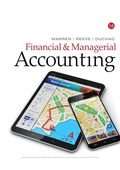
A.
Ratio analysis
It is the financial analysis tool for measuring the profitability, liquidity, capability and overall performance of a company.
Following are the two measures of liquidity:
- 1.
Current ratio : Current ratio is used to determine the relationship between current assets and current liabilities. The ideal current ratio is 2:1. - 2. Quick ratio: Quick ratio measures the immediate debt paying capacity of a business, which can be measured by dividing quick assets by the current liabilities. Quick assets represent cash, readily marketable securities, and
accounts receivable . - 3.
Working capital : Total current assets minus total current liabilities are the working capital of a company.
To Explain: That the working capital is a good measure of relative liquidity in comparing the two companies.
B.
Ratio analysis
It is the financial analysis tool for measuring the profitability, liquidity, capability and overall performance of a company.
Following are the two measures of liquidity:
- 1. Current ratio: Current ratio is used to determine the relationship between current assets and current liabilities. The ideal current ratio is 2:1.
- 2. Quick ratio: Quick ratio measures the immediate debt paying capacity of a business, which can be measured by dividing quick assets by the current liabilities. Quick assets represent cash, readily marketable securities, and accounts receivable.
- 3. Working capital: Total current assets minus total current liabilities are the working capital of a company.
To compute: The quick ratio for each company.
C.
Ratio analysis
It is the financial analysis tool for measuring the profitability, liquidity, capability and overall performance of a company.
Following are the two measures of liquidity:
- 1. Current ratio: Current ratio is used to determine the relationship between current assets and current liabilities. The ideal current ratio is 2:1.
- 2. Quick ratio: Quick ratio measures the immediate debt paying capacity of a business, which can be measured by dividing quick assets by the current liabilities. Quick assets represent cash, readily marketable securities, and accounts receivable.
- 3. Working capital: Total current assets minus total current liabilities are the working capital of a company.
To interpret: The results of quick ratio.
Want to see the full answer?
Check out a sample textbook solution
Chapter 10 Solutions
Financial & Managerial Accounting
- Critically analyse the role of financial reporting in investment decision-making,emphasizing the qualitative characteristics that enhance the usefulness of financialstatements. Discuss how financial reporting influences both investor confidence andregulatory decisions, using relevant examples.arrow_forwardHelp need!!arrow_forwardAnswer please correarrow_forward
- Answer should be coarrow_forwardSolve quiarrow_forwardAssess the role of modern accounting theories in guiding research in accounting.Discuss how contemporary theories, such as stakeholder theory, legitimacy theory, andbehavioral accounting theory, shape research questions, hypotheses formulation, andempirical analysis.arrow_forward
- Need answerarrow_forwardDefine research methodology in the context of accounting theory and discuss theimportance of selecting appropriate research methodology. Evaluate the strengths andlimitations of quantitative and qualitative approaches in accounting research.arrow_forwardCritically evaluate the progress and challenges in achieving a single set of globalaccounting standards. Discuss the benefits and drawbacks of globalization inaccounting, providing relevant examples.arrow_forward
 Financial And Managerial AccountingAccountingISBN:9781337902663Author:WARREN, Carl S.Publisher:Cengage Learning,
Financial And Managerial AccountingAccountingISBN:9781337902663Author:WARREN, Carl S.Publisher:Cengage Learning,

